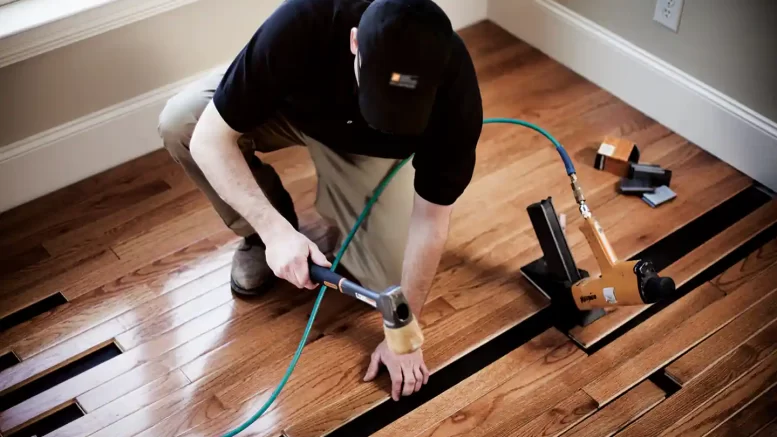Laminate is a modern floor covering used mainly in residential and office premises. The service life of the decorative material largely depends on how well the base is prepared. The answer to the question of how to properly prepare the floor for laminate depends on the design features of the base surface, its condition, and the planned budget.
Why level the subfloor before laying laminate
The base on which the lamellas will be laid must be level. The presence of depressions and elevations leads to unpleasant consequences:
- increases the load on individual planks and causes them to fail quickly;
- reduces the service life of locking connections: if the coating springs under dynamic loads, the locks quickly become loose and break;
- causes a creaking sound when walking on the slats.
The base must be protected from moisture. Accumulation of water under the lamellas leads to the formation and development of fungus, which is harmful to people and animals and leads to the gradual destruction of the decorative coating.
Some of the problems associated with leveling the base can be solved by choosing the right underlay. The ideal option for reducing reflected noise is Silent Walk. This material is well suited for heated floors. For places with frequent traffic, use the UniSound underlay, and for upper floors, use TransitSound. The Basic Plus option is an economical base for laminate floors in low-traffic areas.
Can old flooring serve as a base for laminate flooring?
Laminate planks can be laid over almost any old flooring except carpet, which crushes the pile unevenly, creating an uneven base layer.
Linoleum
Old linoleum does not need to be removed if it does not have holes, peeling or bumps. The best option is linoleum glued to the base over the entire area. In this case, you can save on buying a backing.
Ceramic or porcelain tiles
Removing tiles is difficult and time-consuming, so in most cases they are left in place. High-quality tile covering without cracks, chips, loosely fixed elements is a good base for laying underlay and laminate. The Maestros Home Services Thermolevel underlay is intended for installation on a tile base. This material smooths out significant unevenness of the base layer well. The underlay provides additional heat and waterproofing of the floor, protects the locks from loosening and breakage.
On old tile coverings, defects must be eliminated. Small chips are filled, broken tiles are removed and replaced with whole ones of suitable sizes.
How to properly level a concrete floor for laminate flooring: popular options
There are several ways to level a concrete floor. The choice of the appropriate technology is primarily influenced by the condition of the concrete.
Grinding
This option is only suitable for concrete floors with minor differences in height – no more than 5 mm. It is best to use a grinding machine equipped with a built-in vacuum cleaner to perform the work. Models without a vacuum cleaner can only be used with a respirator and safety glasses.
Leveling with repair mixtures
This method is suitable for bases with a slight slope, cracks, potholes. Repair mixtures can have different compositions, but they all have common advantages:
- laid in an even layer;
- dry quickly;
- are characterized by good durability;
- can be used for any type of coating.
Self-leveling mixtures
They are usually used in apartments of multi-storey buildings. Self-leveling mixtures (“self-leveling floors”) allow you to achieve a perfectly horizontal and even surface. Such mixtures are divided into 3 types:
- For deep leveling. The compositions can fill deep cracks and depressions of 10–60 mm.
- To eliminate large cracks. Mixtures containing glue are used to eliminate individual large defects.
- Finishing compounds. Used after eliminating major defects to obtain a perfectly smooth surface.
Self-leveling mixtures are made on the basis of epoxy and polyurethane resins, cement, and gypsum.
Dry screed
This option is only suitable for rooms with high ceilings. Sheet materials are mounted on the beacon beams: chipboard, cement-bonded particle board, plywood, gypsum fiber board. The space between the base and the sheet materials is filled with dry backfill, most often expanded clay granules, which provide good heat and sound insulation characteristics.
How to level a wooden floor
A wooden floor with minor defects can serve as a reliable base for laminate after some preparation. A wooden floor with severe deformations is completely replaced or covered with sheet materials.
Cycling
This technology involves removing the surface layer using a sanding machine. Before processing, all debris is removed from the floor and nails are driven deeper.
Putty
Using putty compounds, defects of various sizes are eliminated. Putty can be starting and finishing. After the composition dries, the putty areas are cleaned with fine-grained sandpaper.
Self-leveling mixtures
Self-leveling floors are used not only for concrete, but also for wooden floors. When using them, it should be remembered that wood is prone to movement when temperature and humidity change. Therefore, self-leveling floors in this case are formed as floating structures, i.e. separated from the walls by damper layers. Before pouring the mixtures, it is necessary to replace rotten or broken boards that weaken the base floor.
Leveling the base before installing laminate flooring is a mandatory step that ensures long-term use of the flooring and maintains its aesthetic appearance.

Be the first to comment on "How To Level the Floor For Laminate"